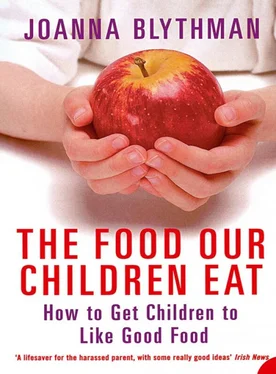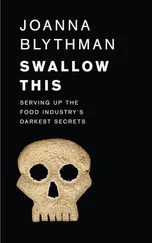• 100 grams of fresh raspberries contains 5.6 grams of sugar. The same weight of tinned raspberries contains 22.5 grams of sugar.
• 100 grams of raw lean beef contains 4.6 grams of fat and 61 milligrams of salt. The same weight of raw beefburger contains 20.5 grams of fat and 600 milligrams of salt.
• 100 grams of tomato purée contains 11.4 grams of sugar and 20 milligrams of salt. The same weight of tomato ketchup contains 22.9 grams of sugar and 1,120 milligrams of salt.
When children – or adults for that matter – eat a diet consisting of whole, unprocessed food cooked at home, it is quite difficult for them to eat a distorted, imbalanced diet. Of course it’s theoretically possible. You could go mad consistently with the butter on your breakfast toast or lashings of cream on that favourite cooked pudding. But your diet is much more likely to go awry when it is composed of processed foods with their vast hidden presence of fat, sugar and salt. So when we base our shopping on whole, unprocessed food, without being self-consciously rigid about ‘healthy eating’, calorie counting or reading nutrition labels, we are giving children food that is much more nutritious and healthy.
The third reason for adopting a real-food approach is that real food can satisfy the tastes of adults and children alike, so the person who buys the food has one shopping list, not the ubiquitous two-household list that must cater for sophisticated adult tastes alongside children’s junk-food palates. Obviously there are households where both adults and children live on processed food and there is no conflict. But where adults do have wider palates and hope that one day their children will share them, a real-food policy makes shopping much easier.
The fourth reason for a real-food policy is that it makes it harder for adults to cave in to demands for junk. How often do you hear adults admitting that they would never eat a certain food themselves but are just ‘buying for the kids’. When you operate this policy, you won’t be buying anything for the children that you wouldn’t want to eat yourself.
Not everyone finds it easy to adopt a real-food approach. Although we all might like to, it can seem impossible given the time pressure we are under. The good news is that, despite food-industry propaganda which says that people have no time to cook any longer and portrays any ‘real’ cooking activity as laborious and time-consuming, a real-food approach doesn’t have to mean endless hours of weary toil in the kitchen after work. It is perfectly possible to feed children on wholesome, fresh food without that. We just need to get into the habit of seeing that ‘fast’ doesn’t always translate into ‘junk’.
In our anxiety about fitting in cooking with all our other demands, it’s easy to assume that a real-food approach would be too time-consuming and impractical. But if we stop to examine that assumption, we may be able to see that it isn’t necessarily the case.
For example, it really doesn’t take much longer to grill a chicken breast than grill or fry some turkey nuggets but it makes for a much better and more wholesome meal. We could slather it with bought pesto and stick it in a toasted pitta bread with some raw vegetables to make an instant meal that will probably appeal to children. A dip made with Greek yogurt and mint to be served with raw vegetable batons can be prepared in minutes and it’s much healthier and ultimately more variable and interesting than chips with ketchup. See pages 239–51 for ideas for fast meals that appeal to both children and adults.
Конец ознакомительного фрагмента.
Текст предоставлен ООО «ЛитРес».
Прочитайте эту книгу целиком, купив полную легальную версию на ЛитРес.
Безопасно оплатить книгу можно банковской картой Visa, MasterCard, Maestro, со счета мобильного телефона, с платежного терминала, в салоне МТС или Связной, через PayPal, WebMoney, Яндекс.Деньги, QIWI Кошелек, бонусными картами или другим удобным Вам способом.











